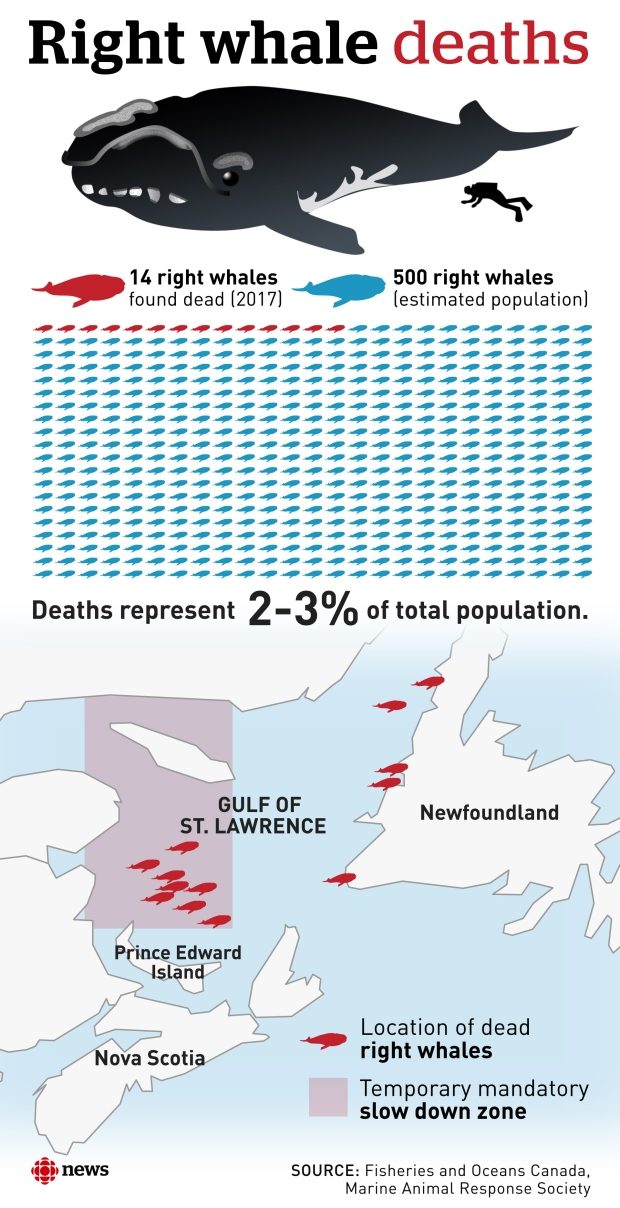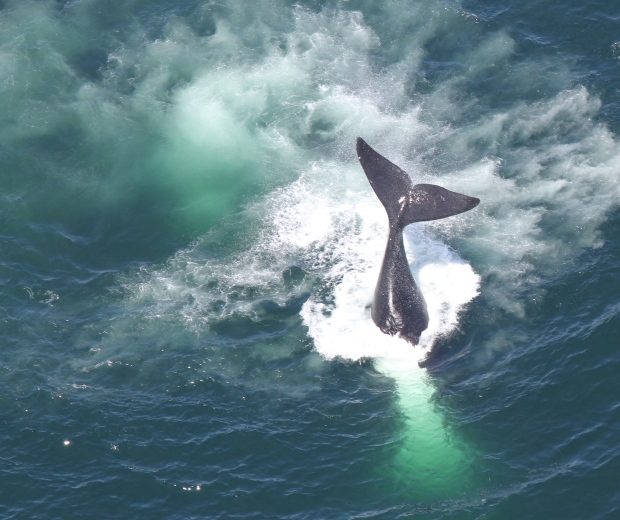Usually, right whales spend the winter in their breeding grounds off Florida and Georgia.
Before 2011, more than 200 right whales were spotted in the area each year. In 2017, there were just seven.
"How tough can it be to find 200 whales? Apparently pretty tough," said Jim Hain, senior scientist at Associated Scientists at Woods Hole, located near Falmouth, Mass.
It's just one of the many puzzles these leviathans present to researchers.
Spike in deaths
North Atlantic right whales have been in the spotlight this year after at least 14 were found dead off the East Coast of Canada and the U.S. The latest dead whale was discovered Friday morning in the Gulf of St. Lawrence.

40% drop in birthrate another mystery
The birthrate of these creatures has dropped by 40 per cent from 2010 to 2016, and scientists don't know why.
Scientists who monitor the whales' migration path between Canadian waters and the southern U.S. spotted just five calves born in 2017, as opposed to the 20 to 25 researchers saw every year through much of the 2000s.
"That's the average that we would be looking for, so it's quite a dramatic drop-off," said Hain, who is also project leader for the Marineland Right Whale Project in Florida and editor of Right Whale News.

Hain said the low birthrate combined with high mortalities this year is a real concern for the species, which has only about 500 individuals left.
Where are the 1st-time mothers?
The five calves born this year present another puzzle for scientists. They were all born to older mothers, raising the question: where are the first-time mothers?
"We would find these in these big social groups of five or six or 12 right whales and they were like teenagers at the mall. There was a lot of bumping and pushing and squealing and poking and all of that sort of thing," said
"Since about 2011, we're not seeing those sub-adults and juveniles in Florida and the question is, well, where are they? If you look around in December to March, there's big groups of juveniles that are somewhere. And where? We don't know."
The problem with tracking tags
With advances in tracking technology, finding the rogue whales may seem as simple as placing an electronic tag on the creatures to follow them to their mystery winter gathering spot.
However, like nearly everything to do with these whales, placing a tracker is not that simple.
The first-generation trackers attempted in the 1990s often resulted in welts on the animals, increasing their risk of infection. The second-generation trackers, which used suction cups or smaller barbs to latch onto the whales, would often break off.
"To make a long story short, what they found was that the impact on the whale didn't justify the results that they were getting," said Hain. "The whales are very social, so they would rub and bump and break the antennas and so many of the tags would fail and not give you any kind of information."
Charles (Stormy) Mayo, senior scientist at the Center for Coastal Studies in Provincetown, Mass., said the costs associated with tagging every individual right whale would be high.
"The funding to keep tags on all right whales or a big proportion would be astronomical," said Mayo.
"To get tags on some individuals that are critical — mothers for instance, know where they calve and the like — that seems within reach. But the basic knowledge of where they go and aggregate is probably pretty far off."
High mortality rate
Hain said though the mortalities this year are of great concern, it's not the first time there's been an alarming number of right whale deaths in a season.
In 1996, at least five North Atlantic right whales were found dead off the coast of Florida.
Between late 2003 and early 2005, another eight dead right whales were reported. These deaths included six adult females, three of whom were carrying fetuses. Researchers found at least four and possibly five of those mortalities were due to human-caused factors.

Because their population is so small, any variability is especially striking. For example, in 2000, researchers counted just one calf. The following year, there were 31. Then in 2009, there were 39 calves.
"The up and down, and the variability, it's just tremendous," said Hain.
"So we have that and then we had a couple of strong years and now we're in a situation where in 2017 we had five calves born, so this variability is just intriguing."
No simple answers
He said the reasons behind the variability are not simple.
"There might be a long-term trend that has to do with climate change. And there is perhaps a cyclical trend where there's some kind of a cycle where these measurements go up and down. And then the third factor that's layered onto there is that there's a random variability that we're having great difficulty explaining," said Hain.
"So that's what makes it such a puzzle."
Scientists continue to work on these questions. Earlier this summer, NOAA, the U.S.-based National Oceanic and Atmospheric Association, declared this year's right whale die-off an unusual mortality event. That means the agency will free up more resources for researchers to investigate the cause.
Additionally, NOAA is working on an endangered species status report for right whales along with an updated monitoring plan.




Reader Comments